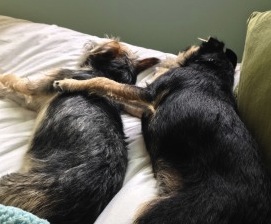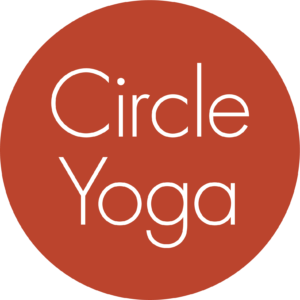November 2013
Dear Friends,

My husband and I adopted two adorable 9-month-old terrier puppy brothers last month. We don’t know much about their stories, but they are very dear to each other and now very dear to us. So far, their lack of verbal communication hasn’t caused any problem in our falling in love with each other.
It’s surprisingly easy for me to understand the puppies without words. In the morning, they wake me up by curling up closer and closer to my face, and when I start to wake up they try to lick me. They make a particular noisy yawn which I have learned means that they need to get outside, NOW. In order to understand what they are trying to say, I must “listen” to them with more than my ears.
“HOW DO I LISTEN TO OTHERS? AS IF EVERYONE WERE MY BELOVED SPEAKING TO ME HIS CHERISHED LAST WORDS.” — FROM “THE GIFT”, VERSIONS OF HAFIZ BY DANIEL LADINSKY
To hear to the puppies’ non-verbal communication, certain qualities of presence are the most helpful: silence, stillness, a relaxed body, gentle curiosity and eye contact, if possible. I wish I used these qualities as often when listening to the humans in my life. Unfortunately, my skill at listening to family and friends is not as well developed as it is at listening to dogs. While on the phone with a friend, I sometimes find myself organizing my desk, cleaning the kitchen, or eating a meal. Even when we are physically together, like at work, it’s not unusual for me to pack my bag or make tea in the midst of a conversation with a co-worker.
So does my ability to listen to non-verbal communication with the dogs have anything to teach me about listening well to people who use words? I have noticed that listening to words often gives rise to my own internal thoughts and stories about those words. Usually the stories have to do with what to say next, agreement or disagreement, or an emotional response such as boredom, annoyance, or fear. And when my reactive thoughts get going they crowd out my authentic mindful presence. That’s when puttering or other distraction begins, and I lose the qualities of stillness, relaxation and curiosity. I can’t really hear what is being communicated anymore, even if I do hear the words. And because of the stream of words continues both externally and internally, I am not usually even aware that I have checked out.
Moving back into non-verbal communication can be a helpful way to reconnect with myself and the other person. Pausing the stream of words is the first step. To do this, I can request a pause or pause myself to take a few breaths. In that non-verbal space, I move back toward authentic listening. I start by listening to myself. Why I am distracting myself? Am I really too busy for this conversation now? Do I think that this conversation could causing harm to someone? Are these words making me feel angry or afraid? — and then I can choose to invite the qualities of listening — stillness, relaxation and curiosity — back, or decide to bring the conversation to a close for now.
“THE ESSENCE OF WORKING WITH ANOTHER PERSON IS TO BE PRESENT AS A LIVING BEING. AND THIS IS LUCKY, BECAUSE IF WE HAD TO BE SMART, OR GOOD, OR MATURE, OR WISE, THEN WE WOULD PROBABLY BE IN TROUBLE…WHAT MATTERS IS TO BE A HUMAN BEING WITH ANOTHER HUMAN BEING, TO RECOGNIZE THE OTHER PERSON AS ANOTHER BEING IN THERE. EVEN IF IT IS A CAT OR A BIRD, IF YOU ARE TRYING TO HELP A WOUNDED BIRD, THE FIRST THING YOU HAVE TO KNOW IS THAT THERE IS SOMEONE IN THERE, AND THAT YOU HAVE TO WAIT FOR THAT ‘PERSON’, THAT BEING IN THERE, TO BE IN CONTACT WITH YOU. THAT SEEMS TO ME TO BE THE MOST IMPORTANT THING.” –GENE GENDLIN
In 2010, the performance artist Marina Abramović spent every day for more than two months sitting in complete silence in front of rotating MoMA visitors who waited in line for hours just for the chance to sit across the table from her. The artist maintained silence, stillness, a relaxed body, and eye contact throughout, and as her title, The Artist is Present, suggests, she was simply present for the visitor. These silent sittings were extremely popular and a documentary was made of the project. MoMA visitors even created a site, MarinaAbramovicMadeMeCry.tumblr.com, to share stories of how sitting in silent presence with Marina had moved them to tears.
I remember being at my first 10-day silent retreat years ago. There were about 80 of us there, and we were instructed to sit in the same spot for each meditation session. Over the 10-days, we sat in silence on that spot for more than 50 hours. Though we never spoke, we certainly connected. I connected especially with a young woman sitting to my right. I noticed when she came late, I wondered if she were sick when she missed a session, and I felt compassion when I heard her quiet tears. On the afternoon of the last day, we had the opportunity to turn to the people near us and say hello. When I turned to the right, my non-verbal friend and I embraced each other with tears streaming down our faces. I never would have believed it, but we felt a very real loving-kindness for each other that grew out of simply sitting together in silence.
Of course we can’t always be in silence, and it would take us much longer to get our needs met if we had to express everything non-verbally. But maybe weaving a little silence, stillness, relaxation and gentle curiosity into our conversations would help us get to a deeper connection with those we choose to communicate with. Instead of letting ourselves get distracted by a steady stream of words, we can remember to invite a breathe or two into our conversations, making space for sharing what might be bigger than words can describe. Like love. Or needing to go out, NOW.
with love,
annie.
